Bioethics Assignment: Ethical Challenges in Modern Medical Practices
VerifiedAdded on 2022/09/14
|15
|4080
|10
Essay
AI Summary
This assignment delves into the core principles and complex debates within bioethics. It begins by critically assessing the statement, "One person's abnormality is another person's life," exploring autonomy and its limits in relation to normality and pathology, referencing topics such as the intersexed and Deaf Culture, and including the issue of enhancement. The paper then examines the conflicts between the principles of autonomy and beneficence, using the issues of refusal of treatment and maternal-fetal conflicts as examples. Furthermore, it explains the persuasive nature of the slippery slope argument in bioethics, discussing its use in debates about euthanasia and genetic revolution. Finally, the assignment details the technological imperative, illustrating its impact with examples like xenotransplantation and severely impaired newborns, providing a comprehensive overview of key ethical considerations in modern medicine.
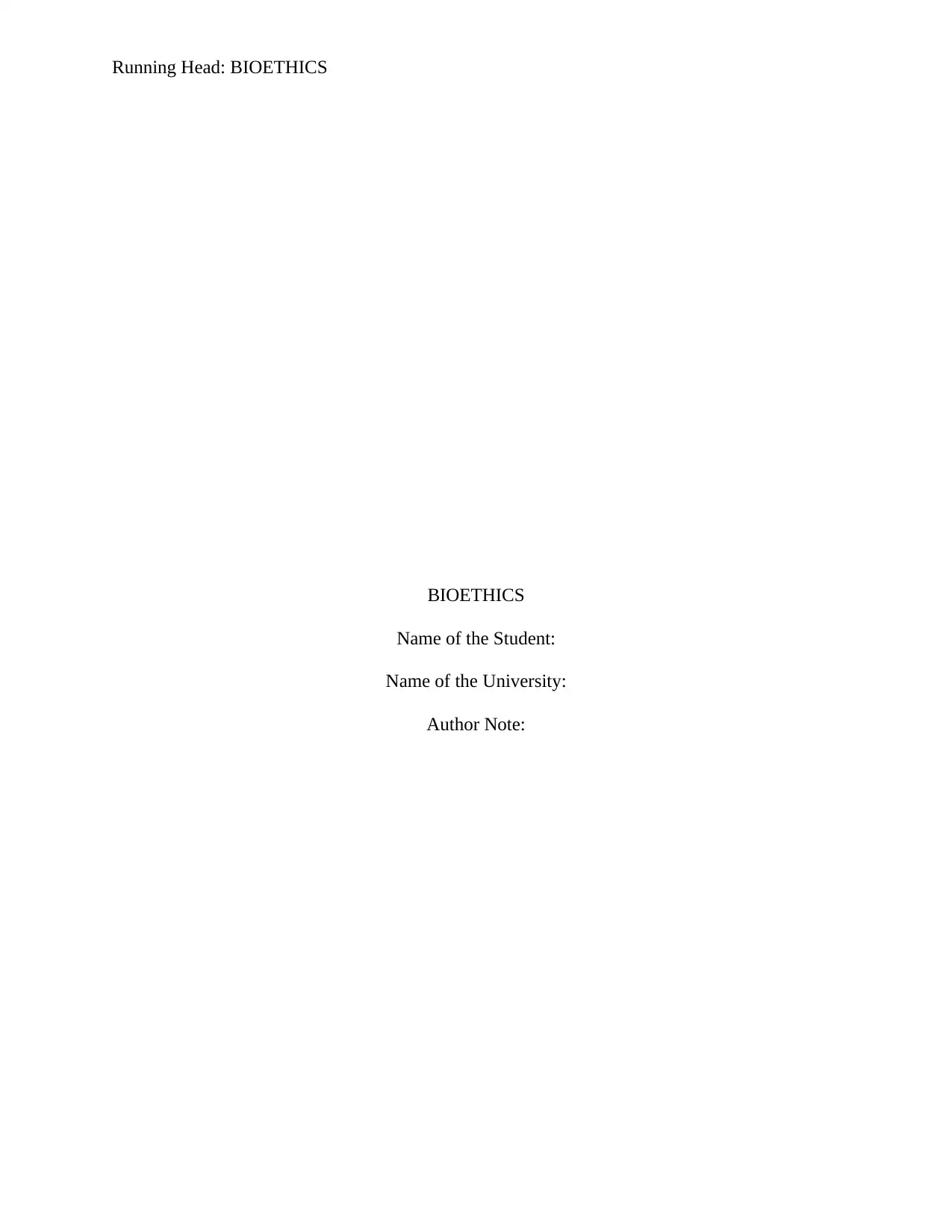
Running Head: BIOETHICS
BIOETHICS
Name of the Student:
Name of the University:
Author Note:
BIOETHICS
Name of the Student:
Name of the University:
Author Note:
Paraphrase This Document
Need a fresh take? Get an instant paraphrase of this document with our AI Paraphraser
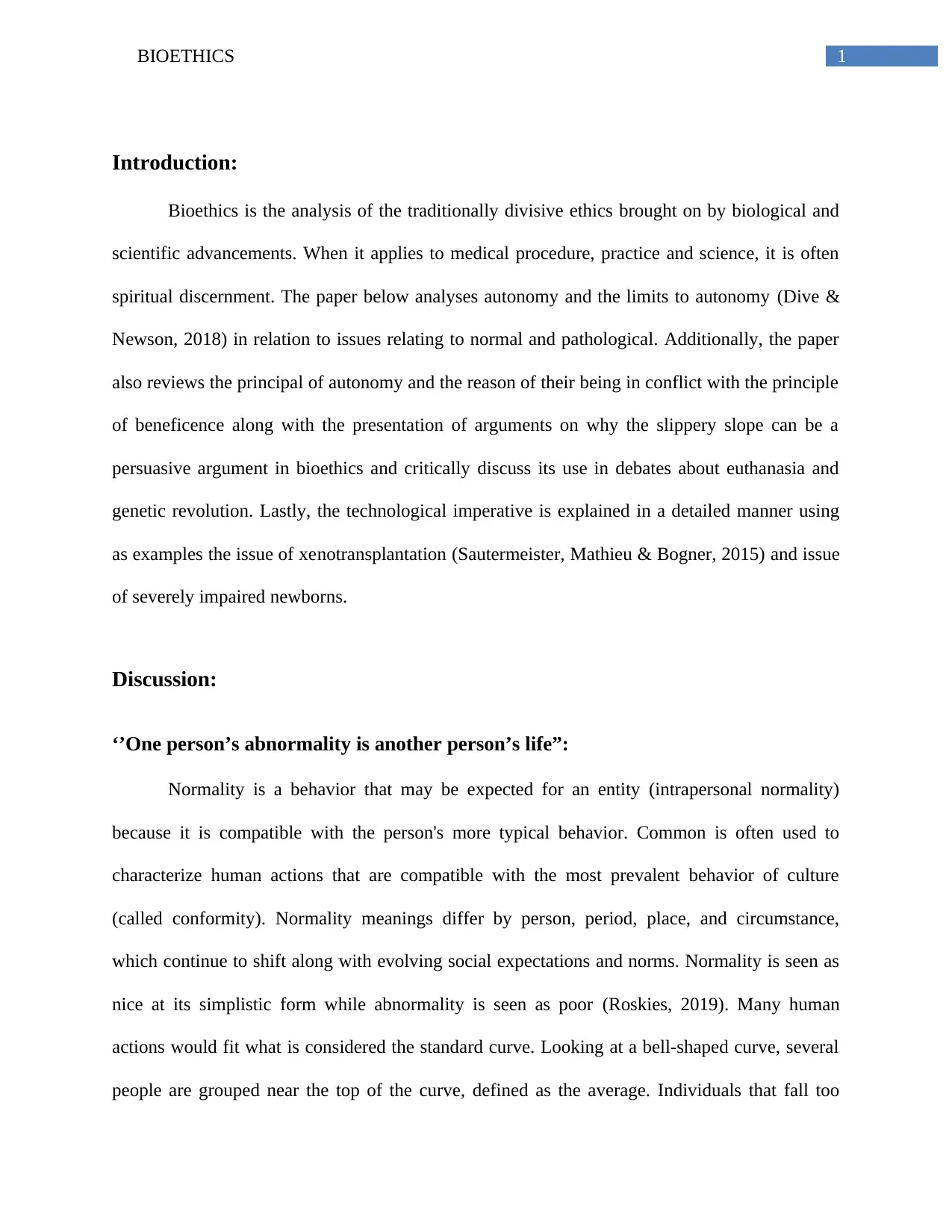
1BIOETHICS
Introduction:
Bioethics is the analysis of the traditionally divisive ethics brought on by biological and
scientific advancements. When it applies to medical procedure, practice and science, it is often
spiritual discernment. The paper below analyses autonomy and the limits to autonomy (Dive &
Newson, 2018) in relation to issues relating to normal and pathological. Additionally, the paper
also reviews the principal of autonomy and the reason of their being in conflict with the principle
of beneficence along with the presentation of arguments on why the slippery slope can be a
persuasive argument in bioethics and critically discuss its use in debates about euthanasia and
genetic revolution. Lastly, the technological imperative is explained in a detailed manner using
as examples the issue of xenotransplantation (Sautermeister, Mathieu & Bogner, 2015) and issue
of severely impaired newborns.
Discussion:
‘’One person’s abnormality is another person’s life”:
Normality is a behavior that may be expected for an entity (intrapersonal normality)
because it is compatible with the person's more typical behavior. Common is often used to
characterize human actions that are compatible with the most prevalent behavior of culture
(called conformity). Normality meanings differ by person, period, place, and circumstance,
which continue to shift along with evolving social expectations and norms. Normality is seen as
nice at its simplistic form while abnormality is seen as poor (Roskies, 2019). Many human
actions would fit what is considered the standard curve. Looking at a bell-shaped curve, several
people are grouped near the top of the curve, defined as the average. Individuals that fall too
Introduction:
Bioethics is the analysis of the traditionally divisive ethics brought on by biological and
scientific advancements. When it applies to medical procedure, practice and science, it is often
spiritual discernment. The paper below analyses autonomy and the limits to autonomy (Dive &
Newson, 2018) in relation to issues relating to normal and pathological. Additionally, the paper
also reviews the principal of autonomy and the reason of their being in conflict with the principle
of beneficence along with the presentation of arguments on why the slippery slope can be a
persuasive argument in bioethics and critically discuss its use in debates about euthanasia and
genetic revolution. Lastly, the technological imperative is explained in a detailed manner using
as examples the issue of xenotransplantation (Sautermeister, Mathieu & Bogner, 2015) and issue
of severely impaired newborns.
Discussion:
‘’One person’s abnormality is another person’s life”:
Normality is a behavior that may be expected for an entity (intrapersonal normality)
because it is compatible with the person's more typical behavior. Common is often used to
characterize human actions that are compatible with the most prevalent behavior of culture
(called conformity). Normality meanings differ by person, period, place, and circumstance,
which continue to shift along with evolving social expectations and norms. Normality is seen as
nice at its simplistic form while abnormality is seen as poor (Roskies, 2019). Many human
actions would fit what is considered the standard curve. Looking at a bell-shaped curve, several
people are grouped near the top of the curve, defined as the average. Individuals that fall too
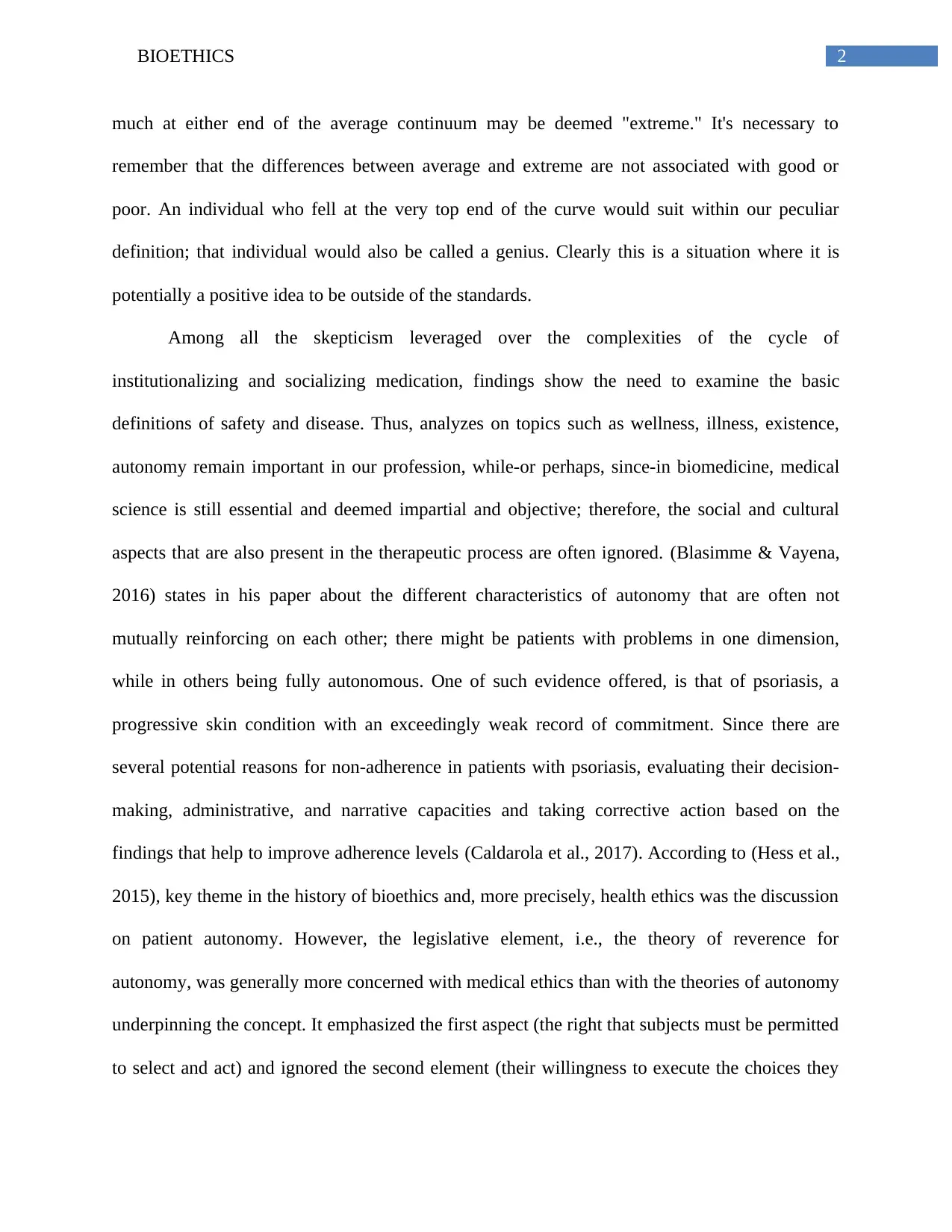
2BIOETHICS
much at either end of the average continuum may be deemed "extreme." It's necessary to
remember that the differences between average and extreme are not associated with good or
poor. An individual who fell at the very top end of the curve would suit within our peculiar
definition; that individual would also be called a genius. Clearly this is a situation where it is
potentially a positive idea to be outside of the standards.
Among all the skepticism leveraged over the complexities of the cycle of
institutionalizing and socializing medication, findings show the need to examine the basic
definitions of safety and disease. Thus, analyzes on topics such as wellness, illness, existence,
autonomy remain important in our profession, while-or perhaps, since-in biomedicine, medical
science is still essential and deemed impartial and objective; therefore, the social and cultural
aspects that are also present in the therapeutic process are often ignored. (Blasimme & Vayena,
2016) states in his paper about the different characteristics of autonomy that are often not
mutually reinforcing on each other; there might be patients with problems in one dimension,
while in others being fully autonomous. One of such evidence offered, is that of psoriasis, a
progressive skin condition with an exceedingly weak record of commitment. Since there are
several potential reasons for non-adherence in patients with psoriasis, evaluating their decision-
making, administrative, and narrative capacities and taking corrective action based on the
findings that help to improve adherence levels (Caldarola et al., 2017). According to (Hess et al.,
2015), key theme in the history of bioethics and, more precisely, health ethics was the discussion
on patient autonomy. However, the legislative element, i.e., the theory of reverence for
autonomy, was generally more concerned with medical ethics than with the theories of autonomy
underpinning the concept. It emphasized the first aspect (the right that subjects must be permitted
to select and act) and ignored the second element (their willingness to execute the choices they
much at either end of the average continuum may be deemed "extreme." It's necessary to
remember that the differences between average and extreme are not associated with good or
poor. An individual who fell at the very top end of the curve would suit within our peculiar
definition; that individual would also be called a genius. Clearly this is a situation where it is
potentially a positive idea to be outside of the standards.
Among all the skepticism leveraged over the complexities of the cycle of
institutionalizing and socializing medication, findings show the need to examine the basic
definitions of safety and disease. Thus, analyzes on topics such as wellness, illness, existence,
autonomy remain important in our profession, while-or perhaps, since-in biomedicine, medical
science is still essential and deemed impartial and objective; therefore, the social and cultural
aspects that are also present in the therapeutic process are often ignored. (Blasimme & Vayena,
2016) states in his paper about the different characteristics of autonomy that are often not
mutually reinforcing on each other; there might be patients with problems in one dimension,
while in others being fully autonomous. One of such evidence offered, is that of psoriasis, a
progressive skin condition with an exceedingly weak record of commitment. Since there are
several potential reasons for non-adherence in patients with psoriasis, evaluating their decision-
making, administrative, and narrative capacities and taking corrective action based on the
findings that help to improve adherence levels (Caldarola et al., 2017). According to (Hess et al.,
2015), key theme in the history of bioethics and, more precisely, health ethics was the discussion
on patient autonomy. However, the legislative element, i.e., the theory of reverence for
autonomy, was generally more concerned with medical ethics than with the theories of autonomy
underpinning the concept. It emphasized the first aspect (the right that subjects must be permitted
to select and act) and ignored the second element (their willingness to execute the choices they
⊘ This is a preview!⊘
Do you want full access?
Subscribe today to unlock all pages.

Trusted by 1+ million students worldwide
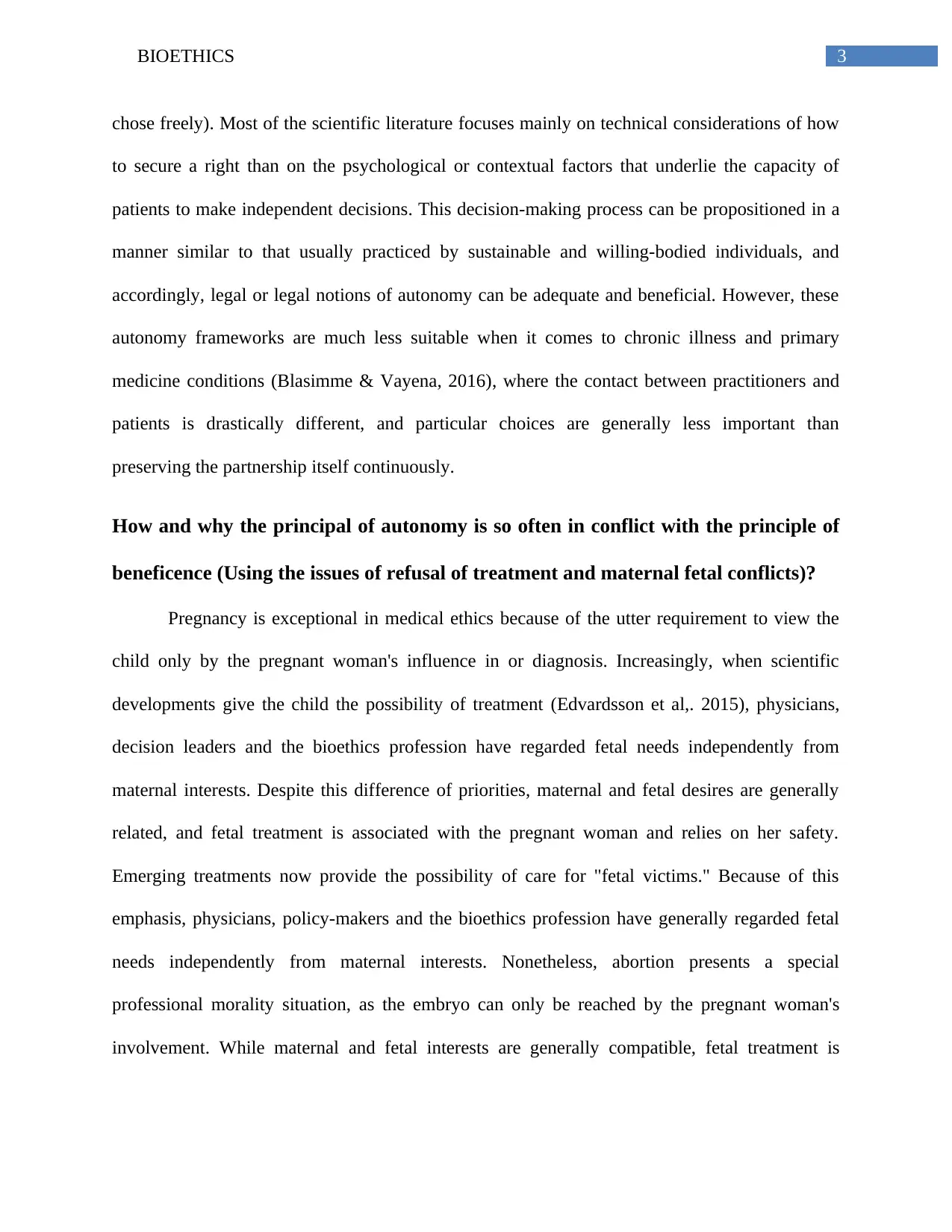
3BIOETHICS
chose freely). Most of the scientific literature focuses mainly on technical considerations of how
to secure a right than on the psychological or contextual factors that underlie the capacity of
patients to make independent decisions. This decision-making process can be propositioned in a
manner similar to that usually practiced by sustainable and willing-bodied individuals, and
accordingly, legal or legal notions of autonomy can be adequate and beneficial. However, these
autonomy frameworks are much less suitable when it comes to chronic illness and primary
medicine conditions (Blasimme & Vayena, 2016), where the contact between practitioners and
patients is drastically different, and particular choices are generally less important than
preserving the partnership itself continuously.
How and why the principal of autonomy is so often in conflict with the principle of
beneficence (Using the issues of refusal of treatment and maternal fetal conflicts)?
Pregnancy is exceptional in medical ethics because of the utter requirement to view the
child only by the pregnant woman's influence in or diagnosis. Increasingly, when scientific
developments give the child the possibility of treatment (Edvardsson et al,. 2015), physicians,
decision leaders and the bioethics profession have regarded fetal needs independently from
maternal interests. Despite this difference of priorities, maternal and fetal desires are generally
related, and fetal treatment is associated with the pregnant woman and relies on her safety.
Emerging treatments now provide the possibility of care for "fetal victims." Because of this
emphasis, physicians, policy-makers and the bioethics profession have generally regarded fetal
needs independently from maternal interests. Nonetheless, abortion presents a special
professional morality situation, as the embryo can only be reached by the pregnant woman's
involvement. While maternal and fetal interests are generally compatible, fetal treatment is
chose freely). Most of the scientific literature focuses mainly on technical considerations of how
to secure a right than on the psychological or contextual factors that underlie the capacity of
patients to make independent decisions. This decision-making process can be propositioned in a
manner similar to that usually practiced by sustainable and willing-bodied individuals, and
accordingly, legal or legal notions of autonomy can be adequate and beneficial. However, these
autonomy frameworks are much less suitable when it comes to chronic illness and primary
medicine conditions (Blasimme & Vayena, 2016), where the contact between practitioners and
patients is drastically different, and particular choices are generally less important than
preserving the partnership itself continuously.
How and why the principal of autonomy is so often in conflict with the principle of
beneficence (Using the issues of refusal of treatment and maternal fetal conflicts)?
Pregnancy is exceptional in medical ethics because of the utter requirement to view the
child only by the pregnant woman's influence in or diagnosis. Increasingly, when scientific
developments give the child the possibility of treatment (Edvardsson et al,. 2015), physicians,
decision leaders and the bioethics profession have regarded fetal needs independently from
maternal interests. Despite this difference of priorities, maternal and fetal desires are generally
related, and fetal treatment is associated with the pregnant woman and relies on her safety.
Emerging treatments now provide the possibility of care for "fetal victims." Because of this
emphasis, physicians, policy-makers and the bioethics profession have generally regarded fetal
needs independently from maternal interests. Nonetheless, abortion presents a special
professional morality situation, as the embryo can only be reached by the pregnant woman's
involvement. While maternal and fetal interests are generally compatible, fetal treatment is
Paraphrase This Document
Need a fresh take? Get an instant paraphrase of this document with our AI Paraphraser
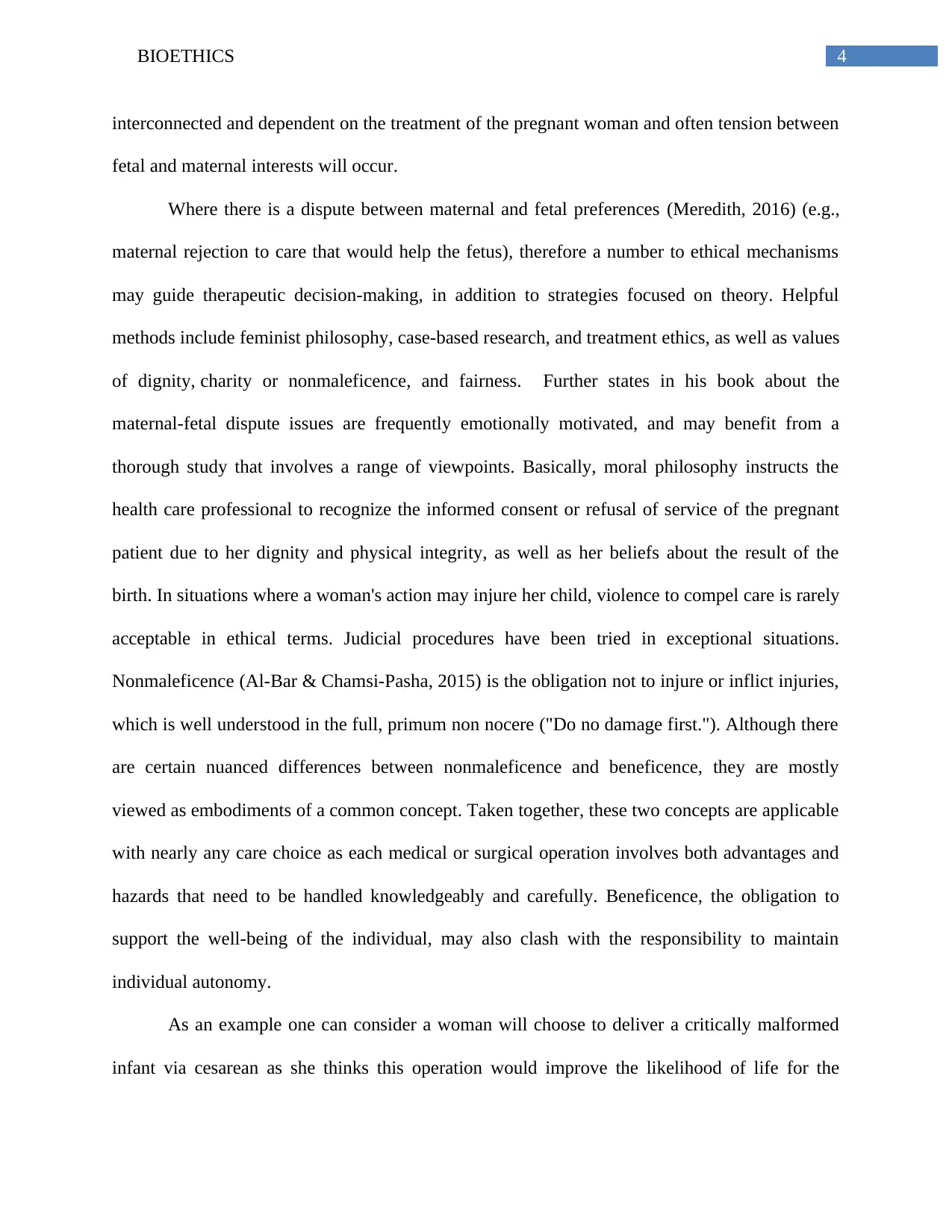
4BIOETHICS
interconnected and dependent on the treatment of the pregnant woman and often tension between
fetal and maternal interests will occur.
Where there is a dispute between maternal and fetal preferences (Meredith, 2016) (e.g.,
maternal rejection to care that would help the fetus), therefore a number to ethical mechanisms
may guide therapeutic decision-making, in addition to strategies focused on theory. Helpful
methods include feminist philosophy, case-based research, and treatment ethics, as well as values
of dignity, charity or nonmaleficence, and fairness. Further states in his book about the
maternal-fetal dispute issues are frequently emotionally motivated, and may benefit from a
thorough study that involves a range of viewpoints. Basically, moral philosophy instructs the
health care professional to recognize the informed consent or refusal of service of the pregnant
patient due to her dignity and physical integrity, as well as her beliefs about the result of the
birth. In situations where a woman's action may injure her child, violence to compel care is rarely
acceptable in ethical terms. Judicial procedures have been tried in exceptional situations.
Nonmaleficence (Al-Bar & Chamsi-Pasha, 2015) is the obligation not to injure or inflict injuries,
which is well understood in the full, primum non nocere ("Do no damage first."). Although there
are certain nuanced differences between nonmaleficence and beneficence, they are mostly
viewed as embodiments of a common concept. Taken together, these two concepts are applicable
with nearly any care choice as each medical or surgical operation involves both advantages and
hazards that need to be handled knowledgeably and carefully. Beneficence, the obligation to
support the well-being of the individual, may also clash with the responsibility to maintain
individual autonomy.
As an example one can consider a woman will choose to deliver a critically malformed
infant via cesarean as she thinks this operation would improve the likelihood of life for the
interconnected and dependent on the treatment of the pregnant woman and often tension between
fetal and maternal interests will occur.
Where there is a dispute between maternal and fetal preferences (Meredith, 2016) (e.g.,
maternal rejection to care that would help the fetus), therefore a number to ethical mechanisms
may guide therapeutic decision-making, in addition to strategies focused on theory. Helpful
methods include feminist philosophy, case-based research, and treatment ethics, as well as values
of dignity, charity or nonmaleficence, and fairness. Further states in his book about the
maternal-fetal dispute issues are frequently emotionally motivated, and may benefit from a
thorough study that involves a range of viewpoints. Basically, moral philosophy instructs the
health care professional to recognize the informed consent or refusal of service of the pregnant
patient due to her dignity and physical integrity, as well as her beliefs about the result of the
birth. In situations where a woman's action may injure her child, violence to compel care is rarely
acceptable in ethical terms. Judicial procedures have been tried in exceptional situations.
Nonmaleficence (Al-Bar & Chamsi-Pasha, 2015) is the obligation not to injure or inflict injuries,
which is well understood in the full, primum non nocere ("Do no damage first."). Although there
are certain nuanced differences between nonmaleficence and beneficence, they are mostly
viewed as embodiments of a common concept. Taken together, these two concepts are applicable
with nearly any care choice as each medical or surgical operation involves both advantages and
hazards that need to be handled knowledgeably and carefully. Beneficence, the obligation to
support the well-being of the individual, may also clash with the responsibility to maintain
individual autonomy.
As an example one can consider a woman will choose to deliver a critically malformed
infant via cesarean as she thinks this operation would improve the likelihood of life for the
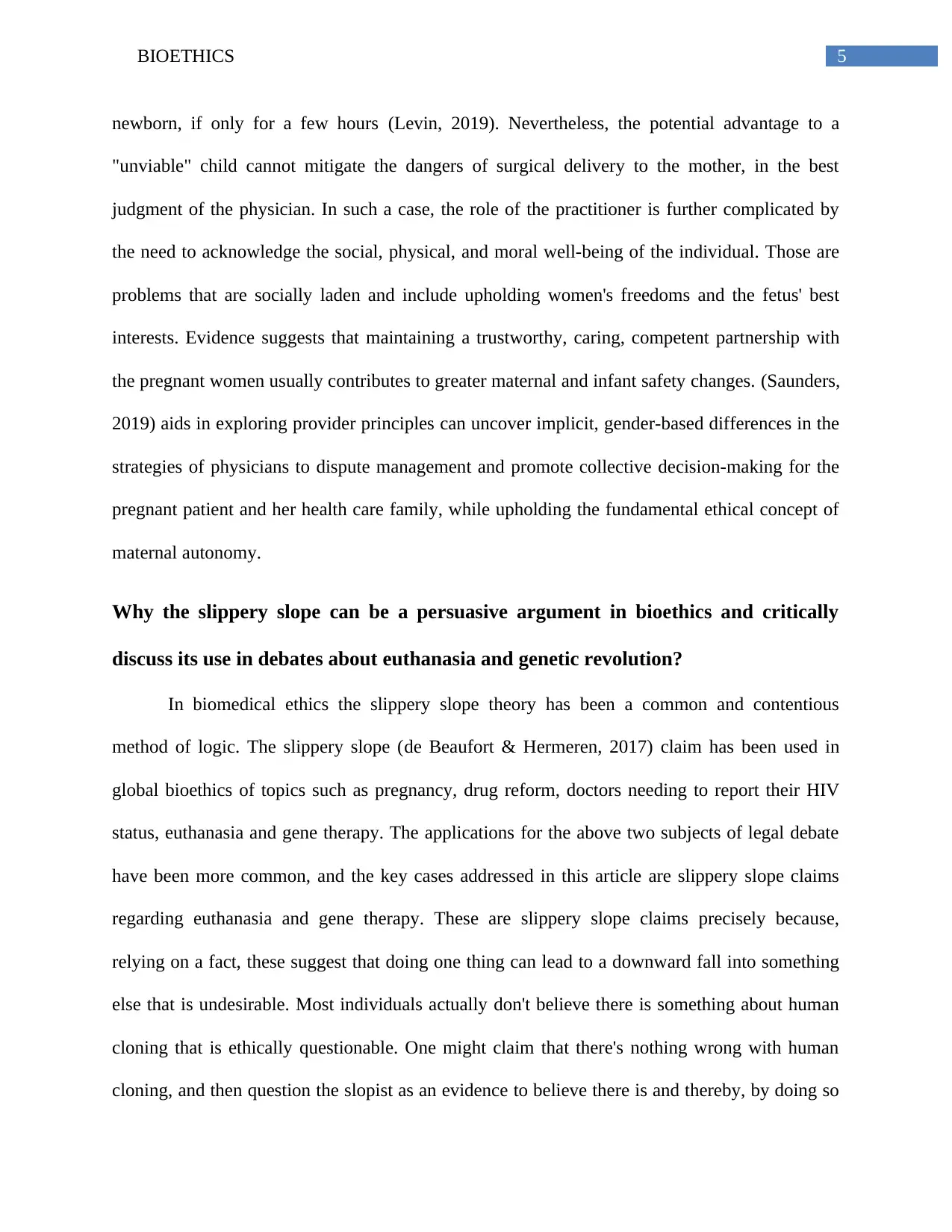
5BIOETHICS
newborn, if only for a few hours (Levin, 2019). Nevertheless, the potential advantage to a
"unviable" child cannot mitigate the dangers of surgical delivery to the mother, in the best
judgment of the physician. In such a case, the role of the practitioner is further complicated by
the need to acknowledge the social, physical, and moral well-being of the individual. Those are
problems that are socially laden and include upholding women's freedoms and the fetus' best
interests. Evidence suggests that maintaining a trustworthy, caring, competent partnership with
the pregnant women usually contributes to greater maternal and infant safety changes. (Saunders,
2019) aids in exploring provider principles can uncover implicit, gender-based differences in the
strategies of physicians to dispute management and promote collective decision-making for the
pregnant patient and her health care family, while upholding the fundamental ethical concept of
maternal autonomy.
Why the slippery slope can be a persuasive argument in bioethics and critically
discuss its use in debates about euthanasia and genetic revolution?
In biomedical ethics the slippery slope theory has been a common and contentious
method of logic. The slippery slope (de Beaufort & Hermeren, 2017) claim has been used in
global bioethics of topics such as pregnancy, drug reform, doctors needing to report their HIV
status, euthanasia and gene therapy. The applications for the above two subjects of legal debate
have been more common, and the key cases addressed in this article are slippery slope claims
regarding euthanasia and gene therapy. These are slippery slope claims precisely because,
relying on a fact, these suggest that doing one thing can lead to a downward fall into something
else that is undesirable. Most individuals actually don't believe there is something about human
cloning that is ethically questionable. One might claim that there's nothing wrong with human
cloning, and then question the slopist as an evidence to believe there is and thereby, by doing so
newborn, if only for a few hours (Levin, 2019). Nevertheless, the potential advantage to a
"unviable" child cannot mitigate the dangers of surgical delivery to the mother, in the best
judgment of the physician. In such a case, the role of the practitioner is further complicated by
the need to acknowledge the social, physical, and moral well-being of the individual. Those are
problems that are socially laden and include upholding women's freedoms and the fetus' best
interests. Evidence suggests that maintaining a trustworthy, caring, competent partnership with
the pregnant women usually contributes to greater maternal and infant safety changes. (Saunders,
2019) aids in exploring provider principles can uncover implicit, gender-based differences in the
strategies of physicians to dispute management and promote collective decision-making for the
pregnant patient and her health care family, while upholding the fundamental ethical concept of
maternal autonomy.
Why the slippery slope can be a persuasive argument in bioethics and critically
discuss its use in debates about euthanasia and genetic revolution?
In biomedical ethics the slippery slope theory has been a common and contentious
method of logic. The slippery slope (de Beaufort & Hermeren, 2017) claim has been used in
global bioethics of topics such as pregnancy, drug reform, doctors needing to report their HIV
status, euthanasia and gene therapy. The applications for the above two subjects of legal debate
have been more common, and the key cases addressed in this article are slippery slope claims
regarding euthanasia and gene therapy. These are slippery slope claims precisely because,
relying on a fact, these suggest that doing one thing can lead to a downward fall into something
else that is undesirable. Most individuals actually don't believe there is something about human
cloning that is ethically questionable. One might claim that there's nothing wrong with human
cloning, and then question the slopist as an evidence to believe there is and thereby, by doing so
⊘ This is a preview!⊘
Do you want full access?
Subscribe today to unlock all pages.

Trusted by 1+ million students worldwide
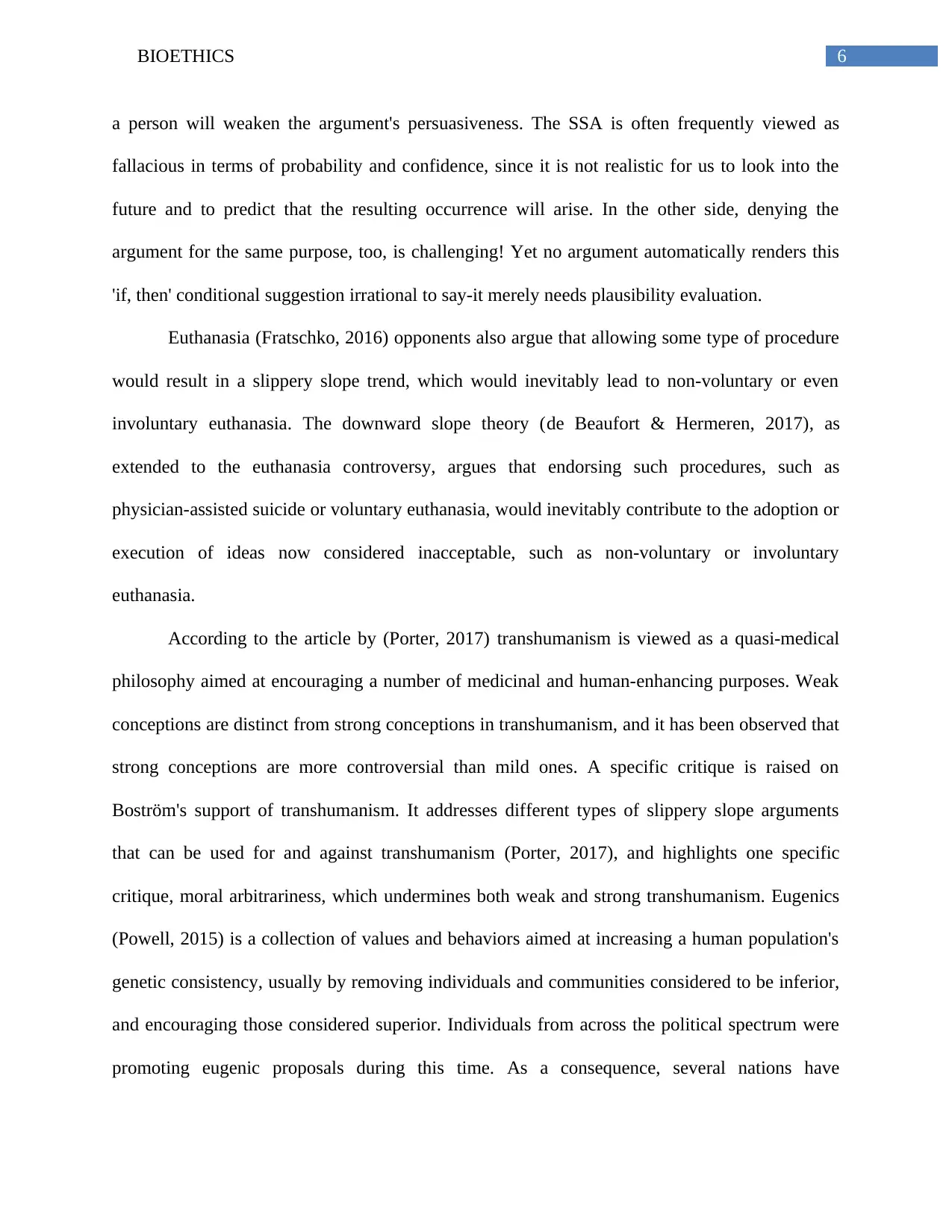
6BIOETHICS
a person will weaken the argument's persuasiveness. The SSA is often frequently viewed as
fallacious in terms of probability and confidence, since it is not realistic for us to look into the
future and to predict that the resulting occurrence will arise. In the other side, denying the
argument for the same purpose, too, is challenging! Yet no argument automatically renders this
'if, then' conditional suggestion irrational to say-it merely needs plausibility evaluation.
Euthanasia (Fratschko, 2016) opponents also argue that allowing some type of procedure
would result in a slippery slope trend, which would inevitably lead to non-voluntary or even
involuntary euthanasia. The downward slope theory (de Beaufort & Hermeren, 2017), as
extended to the euthanasia controversy, argues that endorsing such procedures, such as
physician-assisted suicide or voluntary euthanasia, would inevitably contribute to the adoption or
execution of ideas now considered inacceptable, such as non-voluntary or involuntary
euthanasia.
According to the article by (Porter, 2017) transhumanism is viewed as a quasi-medical
philosophy aimed at encouraging a number of medicinal and human-enhancing purposes. Weak
conceptions are distinct from strong conceptions in transhumanism, and it has been observed that
strong conceptions are more controversial than mild ones. A specific critique is raised on
Boström's support of transhumanism. It addresses different types of slippery slope arguments
that can be used for and against transhumanism (Porter, 2017), and highlights one specific
critique, moral arbitrariness, which undermines both weak and strong transhumanism. Eugenics
(Powell, 2015) is a collection of values and behaviors aimed at increasing a human population's
genetic consistency, usually by removing individuals and communities considered to be inferior,
and encouraging those considered superior. Individuals from across the political spectrum were
promoting eugenic proposals during this time. As a consequence, several nations have
a person will weaken the argument's persuasiveness. The SSA is often frequently viewed as
fallacious in terms of probability and confidence, since it is not realistic for us to look into the
future and to predict that the resulting occurrence will arise. In the other side, denying the
argument for the same purpose, too, is challenging! Yet no argument automatically renders this
'if, then' conditional suggestion irrational to say-it merely needs plausibility evaluation.
Euthanasia (Fratschko, 2016) opponents also argue that allowing some type of procedure
would result in a slippery slope trend, which would inevitably lead to non-voluntary or even
involuntary euthanasia. The downward slope theory (de Beaufort & Hermeren, 2017), as
extended to the euthanasia controversy, argues that endorsing such procedures, such as
physician-assisted suicide or voluntary euthanasia, would inevitably contribute to the adoption or
execution of ideas now considered inacceptable, such as non-voluntary or involuntary
euthanasia.
According to the article by (Porter, 2017) transhumanism is viewed as a quasi-medical
philosophy aimed at encouraging a number of medicinal and human-enhancing purposes. Weak
conceptions are distinct from strong conceptions in transhumanism, and it has been observed that
strong conceptions are more controversial than mild ones. A specific critique is raised on
Boström's support of transhumanism. It addresses different types of slippery slope arguments
that can be used for and against transhumanism (Porter, 2017), and highlights one specific
critique, moral arbitrariness, which undermines both weak and strong transhumanism. Eugenics
(Powell, 2015) is a collection of values and behaviors aimed at increasing a human population's
genetic consistency, usually by removing individuals and communities considered to be inferior,
and encouraging those considered superior. Individuals from across the political spectrum were
promoting eugenic proposals during this time. As a consequence, several nations have
Paraphrase This Document
Need a fresh take? Get an instant paraphrase of this document with our AI Paraphraser
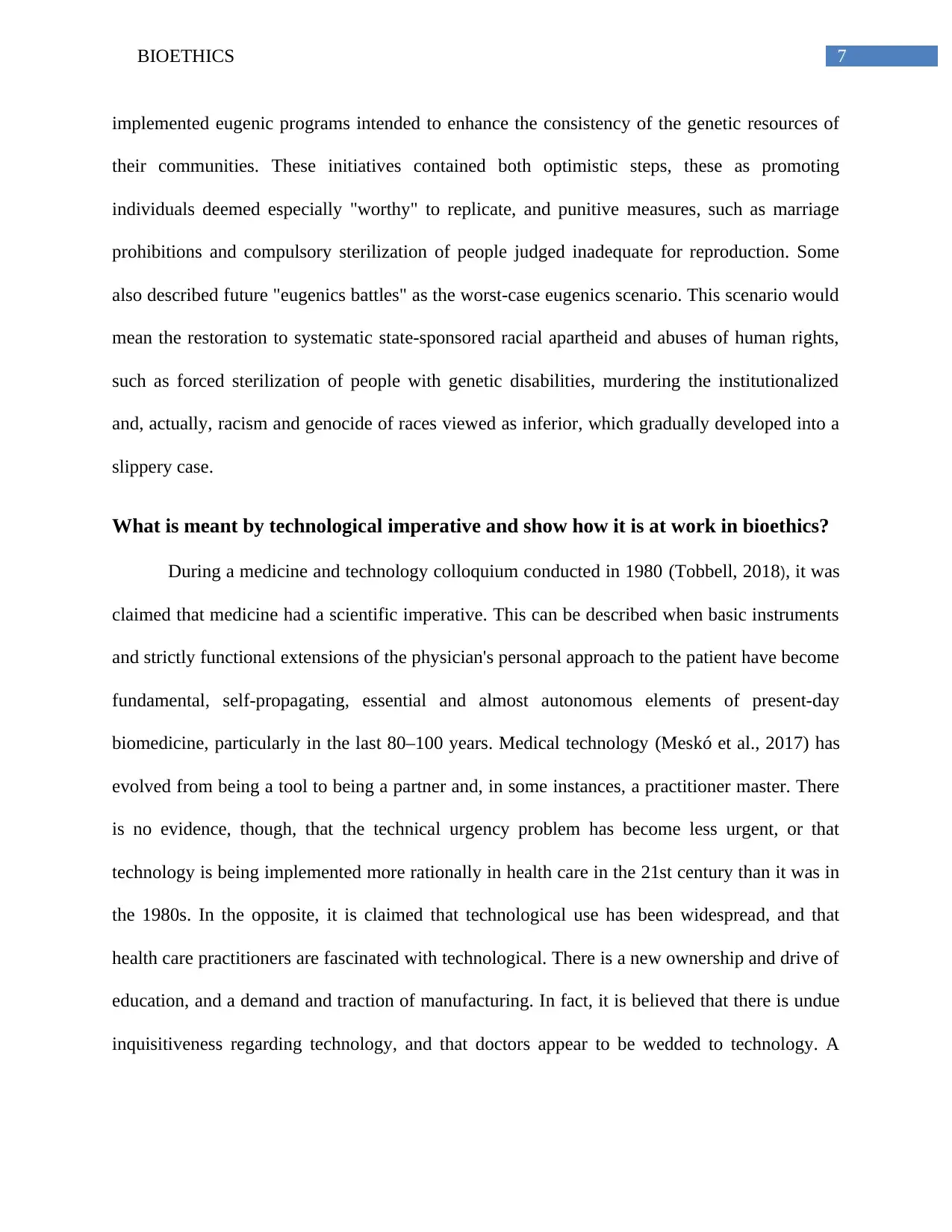
7BIOETHICS
implemented eugenic programs intended to enhance the consistency of the genetic resources of
their communities. These initiatives contained both optimistic steps, these as promoting
individuals deemed especially "worthy" to replicate, and punitive measures, such as marriage
prohibitions and compulsory sterilization of people judged inadequate for reproduction. Some
also described future "eugenics battles" as the worst-case eugenics scenario. This scenario would
mean the restoration to systematic state-sponsored racial apartheid and abuses of human rights,
such as forced sterilization of people with genetic disabilities, murdering the institutionalized
and, actually, racism and genocide of races viewed as inferior, which gradually developed into a
slippery case.
What is meant by technological imperative and show how it is at work in bioethics?
During a medicine and technology colloquium conducted in 1980 (Tobbell, 2018), it was
claimed that medicine had a scientific imperative. This can be described when basic instruments
and strictly functional extensions of the physician's personal approach to the patient have become
fundamental, self-propagating, essential and almost autonomous elements of present-day
biomedicine, particularly in the last 80–100 years. Medical technology (Meskó et al., 2017) has
evolved from being a tool to being a partner and, in some instances, a practitioner master. There
is no evidence, though, that the technical urgency problem has become less urgent, or that
technology is being implemented more rationally in health care in the 21st century than it was in
the 1980s. In the opposite, it is claimed that technological use has been widespread, and that
health care practitioners are fascinated with technological. There is a new ownership and drive of
education, and a demand and traction of manufacturing. In fact, it is believed that there is undue
inquisitiveness regarding technology, and that doctors appear to be wedded to technology. A
implemented eugenic programs intended to enhance the consistency of the genetic resources of
their communities. These initiatives contained both optimistic steps, these as promoting
individuals deemed especially "worthy" to replicate, and punitive measures, such as marriage
prohibitions and compulsory sterilization of people judged inadequate for reproduction. Some
also described future "eugenics battles" as the worst-case eugenics scenario. This scenario would
mean the restoration to systematic state-sponsored racial apartheid and abuses of human rights,
such as forced sterilization of people with genetic disabilities, murdering the institutionalized
and, actually, racism and genocide of races viewed as inferior, which gradually developed into a
slippery case.
What is meant by technological imperative and show how it is at work in bioethics?
During a medicine and technology colloquium conducted in 1980 (Tobbell, 2018), it was
claimed that medicine had a scientific imperative. This can be described when basic instruments
and strictly functional extensions of the physician's personal approach to the patient have become
fundamental, self-propagating, essential and almost autonomous elements of present-day
biomedicine, particularly in the last 80–100 years. Medical technology (Meskó et al., 2017) has
evolved from being a tool to being a partner and, in some instances, a practitioner master. There
is no evidence, though, that the technical urgency problem has become less urgent, or that
technology is being implemented more rationally in health care in the 21st century than it was in
the 1980s. In the opposite, it is claimed that technological use has been widespread, and that
health care practitioners are fascinated with technological. There is a new ownership and drive of
education, and a demand and traction of manufacturing. In fact, it is believed that there is undue
inquisitiveness regarding technology, and that doctors appear to be wedded to technology. A
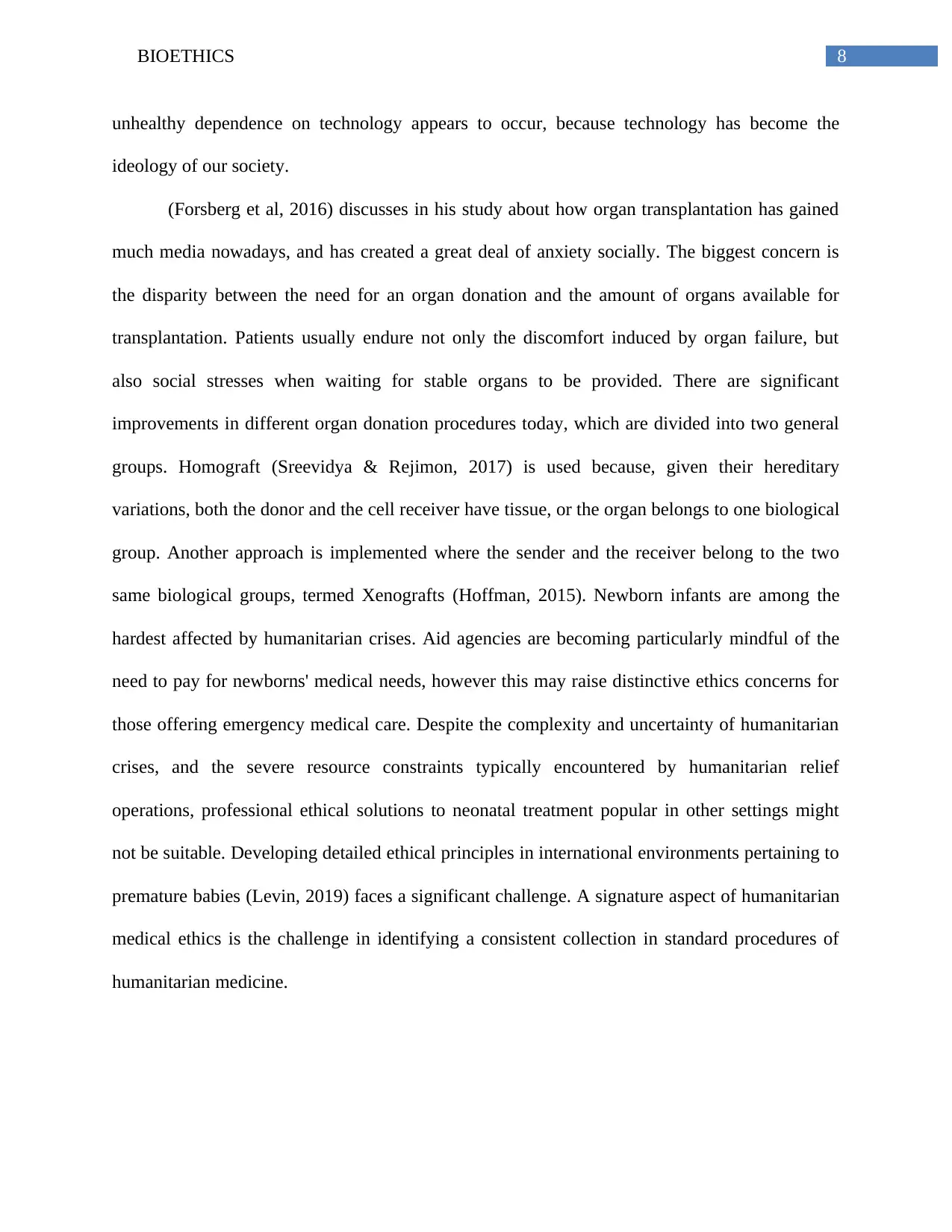
8BIOETHICS
unhealthy dependence on technology appears to occur, because technology has become the
ideology of our society.
(Forsberg et al, 2016) discusses in his study about how organ transplantation has gained
much media nowadays, and has created a great deal of anxiety socially. The biggest concern is
the disparity between the need for an organ donation and the amount of organs available for
transplantation. Patients usually endure not only the discomfort induced by organ failure, but
also social stresses when waiting for stable organs to be provided. There are significant
improvements in different organ donation procedures today, which are divided into two general
groups. Homograft (Sreevidya & Rejimon, 2017) is used because, given their hereditary
variations, both the donor and the cell receiver have tissue, or the organ belongs to one biological
group. Another approach is implemented where the sender and the receiver belong to the two
same biological groups, termed Xenografts (Hoffman, 2015). Newborn infants are among the
hardest affected by humanitarian crises. Aid agencies are becoming particularly mindful of the
need to pay for newborns' medical needs, however this may raise distinctive ethics concerns for
those offering emergency medical care. Despite the complexity and uncertainty of humanitarian
crises, and the severe resource constraints typically encountered by humanitarian relief
operations, professional ethical solutions to neonatal treatment popular in other settings might
not be suitable. Developing detailed ethical principles in international environments pertaining to
premature babies (Levin, 2019) faces a significant challenge. A signature aspect of humanitarian
medical ethics is the challenge in identifying a consistent collection in standard procedures of
humanitarian medicine.
unhealthy dependence on technology appears to occur, because technology has become the
ideology of our society.
(Forsberg et al, 2016) discusses in his study about how organ transplantation has gained
much media nowadays, and has created a great deal of anxiety socially. The biggest concern is
the disparity between the need for an organ donation and the amount of organs available for
transplantation. Patients usually endure not only the discomfort induced by organ failure, but
also social stresses when waiting for stable organs to be provided. There are significant
improvements in different organ donation procedures today, which are divided into two general
groups. Homograft (Sreevidya & Rejimon, 2017) is used because, given their hereditary
variations, both the donor and the cell receiver have tissue, or the organ belongs to one biological
group. Another approach is implemented where the sender and the receiver belong to the two
same biological groups, termed Xenografts (Hoffman, 2015). Newborn infants are among the
hardest affected by humanitarian crises. Aid agencies are becoming particularly mindful of the
need to pay for newborns' medical needs, however this may raise distinctive ethics concerns for
those offering emergency medical care. Despite the complexity and uncertainty of humanitarian
crises, and the severe resource constraints typically encountered by humanitarian relief
operations, professional ethical solutions to neonatal treatment popular in other settings might
not be suitable. Developing detailed ethical principles in international environments pertaining to
premature babies (Levin, 2019) faces a significant challenge. A signature aspect of humanitarian
medical ethics is the challenge in identifying a consistent collection in standard procedures of
humanitarian medicine.
⊘ This is a preview!⊘
Do you want full access?
Subscribe today to unlock all pages.

Trusted by 1+ million students worldwide
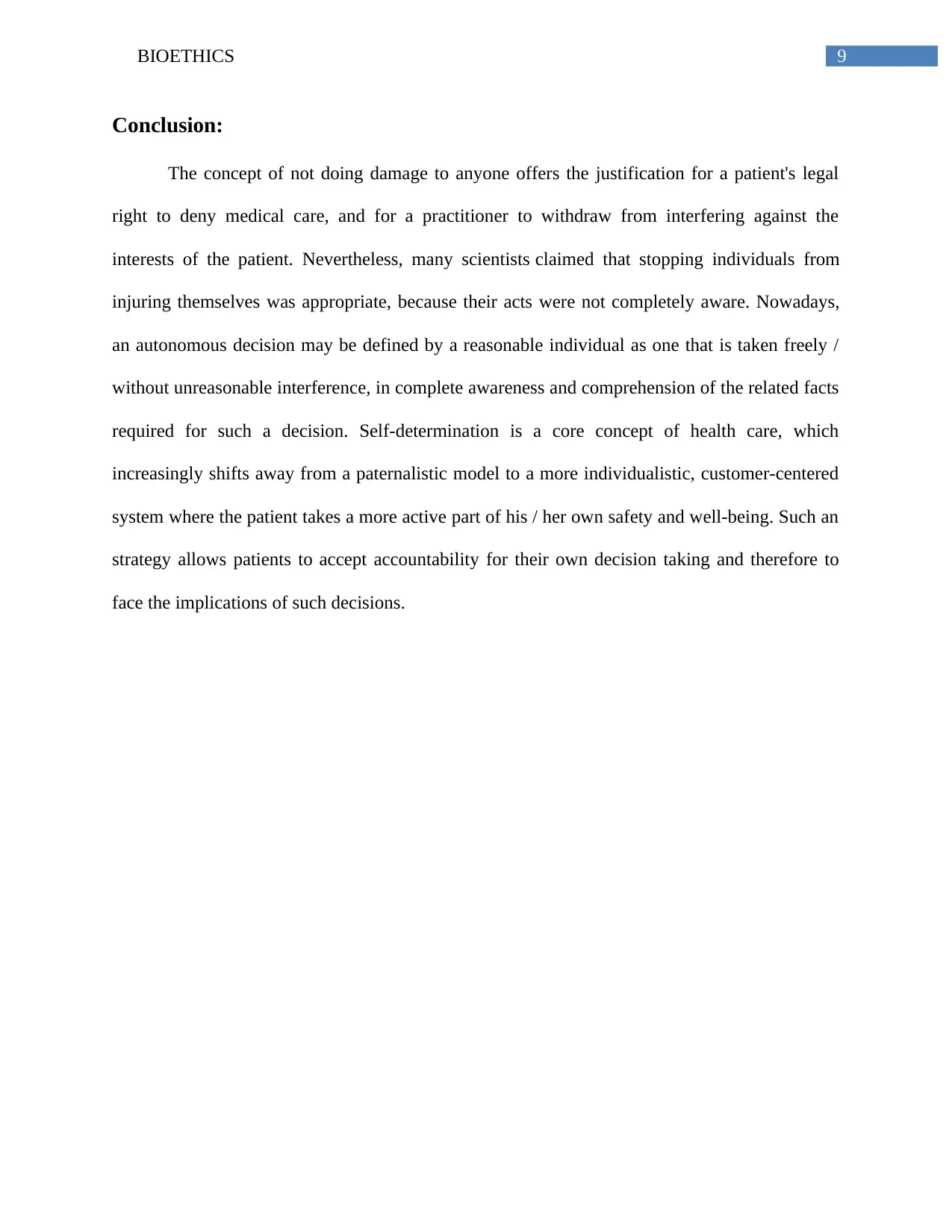
9BIOETHICS
Conclusion:
The concept of not doing damage to anyone offers the justification for a patient's legal
right to deny medical care, and for a practitioner to withdraw from interfering against the
interests of the patient. Nevertheless, many scientists claimed that stopping individuals from
injuring themselves was appropriate, because their acts were not completely aware. Nowadays,
an autonomous decision may be defined by a reasonable individual as one that is taken freely /
without unreasonable interference, in complete awareness and comprehension of the related facts
required for such a decision. Self-determination is a core concept of health care, which
increasingly shifts away from a paternalistic model to a more individualistic, customer-centered
system where the patient takes a more active part of his / her own safety and well-being. Such an
strategy allows patients to accept accountability for their own decision taking and therefore to
face the implications of such decisions.
Conclusion:
The concept of not doing damage to anyone offers the justification for a patient's legal
right to deny medical care, and for a practitioner to withdraw from interfering against the
interests of the patient. Nevertheless, many scientists claimed that stopping individuals from
injuring themselves was appropriate, because their acts were not completely aware. Nowadays,
an autonomous decision may be defined by a reasonable individual as one that is taken freely /
without unreasonable interference, in complete awareness and comprehension of the related facts
required for such a decision. Self-determination is a core concept of health care, which
increasingly shifts away from a paternalistic model to a more individualistic, customer-centered
system where the patient takes a more active part of his / her own safety and well-being. Such an
strategy allows patients to accept accountability for their own decision taking and therefore to
face the implications of such decisions.
Paraphrase This Document
Need a fresh take? Get an instant paraphrase of this document with our AI Paraphraser
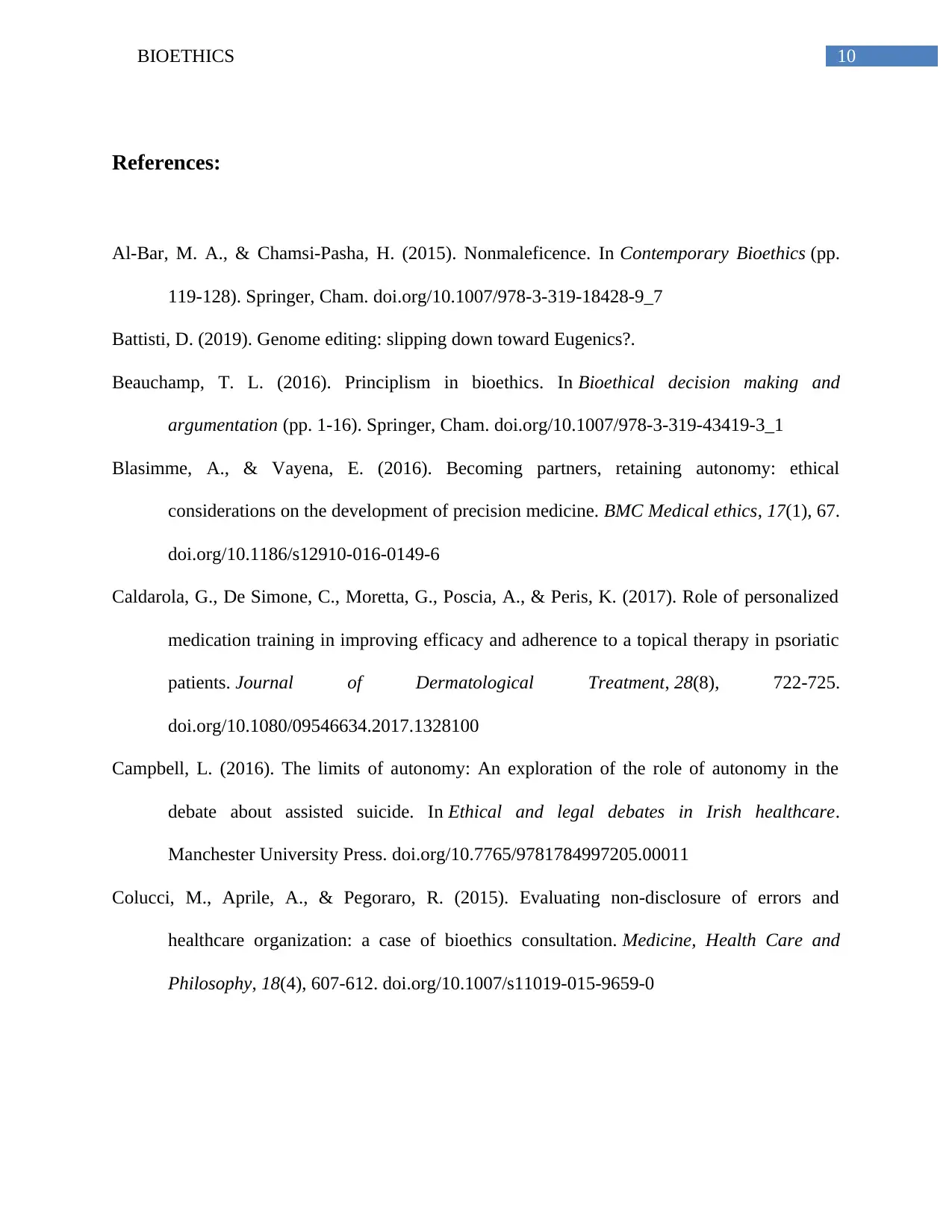
10BIOETHICS
References:
Al-Bar, M. A., & Chamsi-Pasha, H. (2015). Nonmaleficence. In Contemporary Bioethics (pp.
119-128). Springer, Cham. doi.org/10.1007/978-3-319-18428-9_7
Battisti, D. (2019). Genome editing: slipping down toward Eugenics?.
Beauchamp, T. L. (2016). Principlism in bioethics. In Bioethical decision making and
argumentation (pp. 1-16). Springer, Cham. doi.org/10.1007/978-3-319-43419-3_1
Blasimme, A., & Vayena, E. (2016). Becoming partners, retaining autonomy: ethical
considerations on the development of precision medicine. BMC Medical ethics, 17(1), 67.
doi.org/10.1186/s12910-016-0149-6
Caldarola, G., De Simone, C., Moretta, G., Poscia, A., & Peris, K. (2017). Role of personalized
medication training in improving efficacy and adherence to a topical therapy in psoriatic
patients. Journal of Dermatological Treatment, 28(8), 722-725.
doi.org/10.1080/09546634.2017.1328100
Campbell, L. (2016). The limits of autonomy: An exploration of the role of autonomy in the
debate about assisted suicide. In Ethical and legal debates in Irish healthcare.
Manchester University Press. doi.org/10.7765/9781784997205.00011
Colucci, M., Aprile, A., & Pegoraro, R. (2015). Evaluating non-disclosure of errors and
healthcare organization: a case of bioethics consultation. Medicine, Health Care and
Philosophy, 18(4), 607-612. doi.org/10.1007/s11019-015-9659-0
References:
Al-Bar, M. A., & Chamsi-Pasha, H. (2015). Nonmaleficence. In Contemporary Bioethics (pp.
119-128). Springer, Cham. doi.org/10.1007/978-3-319-18428-9_7
Battisti, D. (2019). Genome editing: slipping down toward Eugenics?.
Beauchamp, T. L. (2016). Principlism in bioethics. In Bioethical decision making and
argumentation (pp. 1-16). Springer, Cham. doi.org/10.1007/978-3-319-43419-3_1
Blasimme, A., & Vayena, E. (2016). Becoming partners, retaining autonomy: ethical
considerations on the development of precision medicine. BMC Medical ethics, 17(1), 67.
doi.org/10.1186/s12910-016-0149-6
Caldarola, G., De Simone, C., Moretta, G., Poscia, A., & Peris, K. (2017). Role of personalized
medication training in improving efficacy and adherence to a topical therapy in psoriatic
patients. Journal of Dermatological Treatment, 28(8), 722-725.
doi.org/10.1080/09546634.2017.1328100
Campbell, L. (2016). The limits of autonomy: An exploration of the role of autonomy in the
debate about assisted suicide. In Ethical and legal debates in Irish healthcare.
Manchester University Press. doi.org/10.7765/9781784997205.00011
Colucci, M., Aprile, A., & Pegoraro, R. (2015). Evaluating non-disclosure of errors and
healthcare organization: a case of bioethics consultation. Medicine, Health Care and
Philosophy, 18(4), 607-612. doi.org/10.1007/s11019-015-9659-0
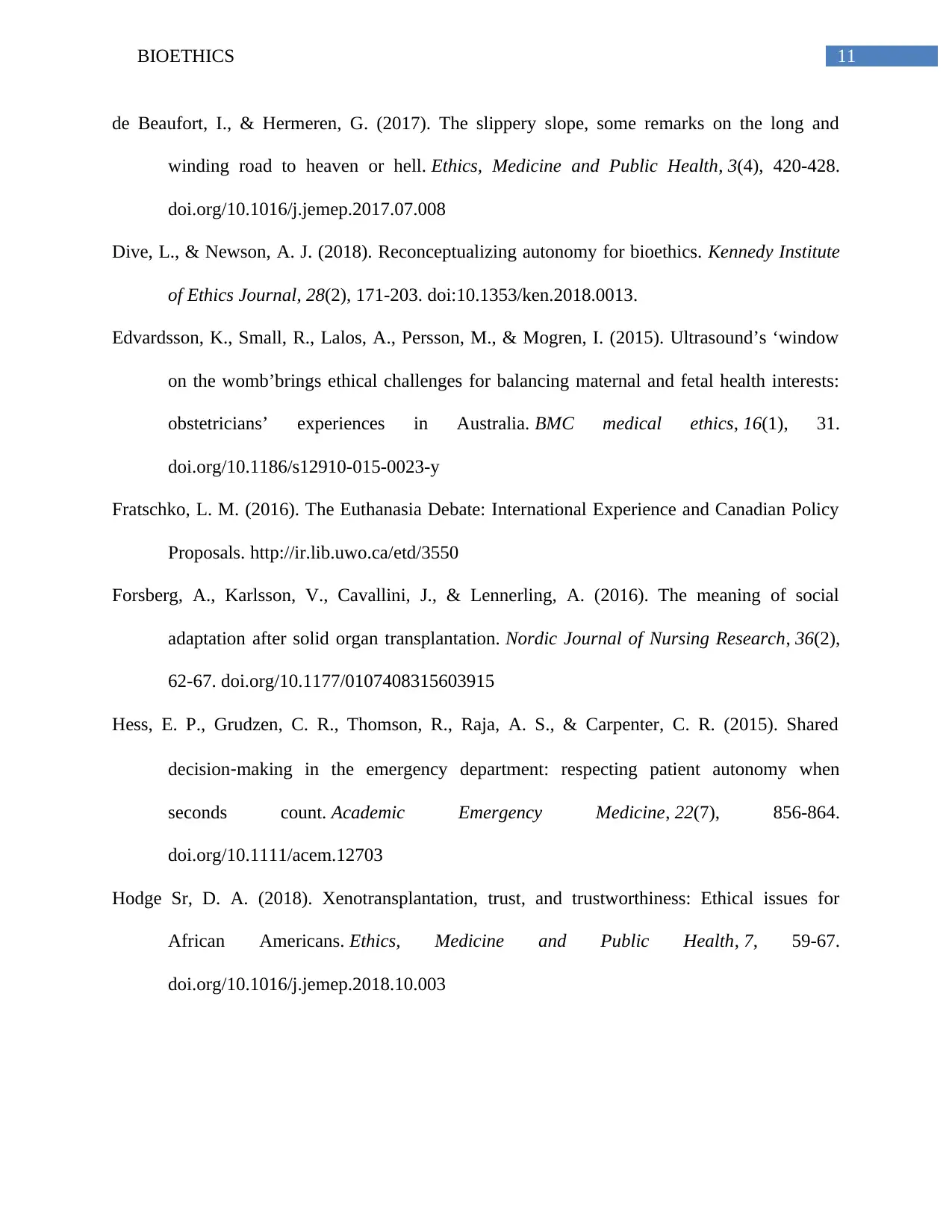
11BIOETHICS
de Beaufort, I., & Hermeren, G. (2017). The slippery slope, some remarks on the long and
winding road to heaven or hell. Ethics, Medicine and Public Health, 3(4), 420-428.
doi.org/10.1016/j.jemep.2017.07.008
Dive, L., & Newson, A. J. (2018). Reconceptualizing autonomy for bioethics. Kennedy Institute
of Ethics Journal, 28(2), 171-203. doi:10.1353/ken.2018.0013.
Edvardsson, K., Small, R., Lalos, A., Persson, M., & Mogren, I. (2015). Ultrasound’s ‘window
on the womb’brings ethical challenges for balancing maternal and fetal health interests:
obstetricians’ experiences in Australia. BMC medical ethics, 16(1), 31.
doi.org/10.1186/s12910-015-0023-y
Fratschko, L. M. (2016). The Euthanasia Debate: International Experience and Canadian Policy
Proposals. http://ir.lib.uwo.ca/etd/3550
Forsberg, A., Karlsson, V., Cavallini, J., & Lennerling, A. (2016). The meaning of social
adaptation after solid organ transplantation. Nordic Journal of Nursing Research, 36(2),
62-67. doi.org/10.1177/0107408315603915
Hess, E. P., Grudzen, C. R., Thomson, R., Raja, A. S., & Carpenter, C. R. (2015). Shared
decision‐making in the emergency department: respecting patient autonomy when
seconds count. Academic Emergency Medicine, 22(7), 856-864.
doi.org/10.1111/acem.12703
Hodge Sr, D. A. (2018). Xenotransplantation, trust, and trustworthiness: Ethical issues for
African Americans. Ethics, Medicine and Public Health, 7, 59-67.
doi.org/10.1016/j.jemep.2018.10.003
de Beaufort, I., & Hermeren, G. (2017). The slippery slope, some remarks on the long and
winding road to heaven or hell. Ethics, Medicine and Public Health, 3(4), 420-428.
doi.org/10.1016/j.jemep.2017.07.008
Dive, L., & Newson, A. J. (2018). Reconceptualizing autonomy for bioethics. Kennedy Institute
of Ethics Journal, 28(2), 171-203. doi:10.1353/ken.2018.0013.
Edvardsson, K., Small, R., Lalos, A., Persson, M., & Mogren, I. (2015). Ultrasound’s ‘window
on the womb’brings ethical challenges for balancing maternal and fetal health interests:
obstetricians’ experiences in Australia. BMC medical ethics, 16(1), 31.
doi.org/10.1186/s12910-015-0023-y
Fratschko, L. M. (2016). The Euthanasia Debate: International Experience and Canadian Policy
Proposals. http://ir.lib.uwo.ca/etd/3550
Forsberg, A., Karlsson, V., Cavallini, J., & Lennerling, A. (2016). The meaning of social
adaptation after solid organ transplantation. Nordic Journal of Nursing Research, 36(2),
62-67. doi.org/10.1177/0107408315603915
Hess, E. P., Grudzen, C. R., Thomson, R., Raja, A. S., & Carpenter, C. R. (2015). Shared
decision‐making in the emergency department: respecting patient autonomy when
seconds count. Academic Emergency Medicine, 22(7), 856-864.
doi.org/10.1111/acem.12703
Hodge Sr, D. A. (2018). Xenotransplantation, trust, and trustworthiness: Ethical issues for
African Americans. Ethics, Medicine and Public Health, 7, 59-67.
doi.org/10.1016/j.jemep.2018.10.003
⊘ This is a preview!⊘
Do you want full access?
Subscribe today to unlock all pages.

Trusted by 1+ million students worldwide
1 out of 15
Your All-in-One AI-Powered Toolkit for Academic Success.
+13062052269
info@desklib.com
Available 24*7 on WhatsApp / Email
![[object Object]](/_next/static/media/star-bottom.7253800d.svg)
Unlock your academic potential
Copyright © 2020–2025 A2Z Services. All Rights Reserved. Developed and managed by ZUCOL.